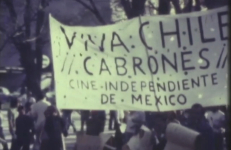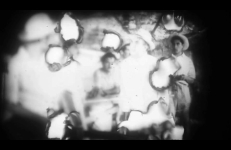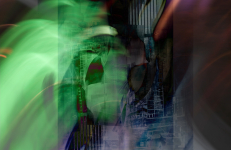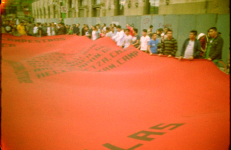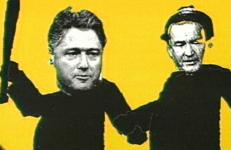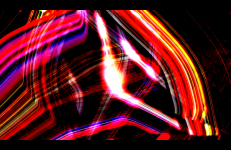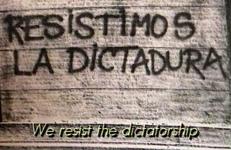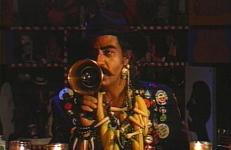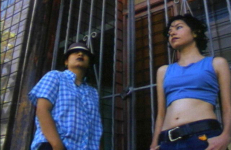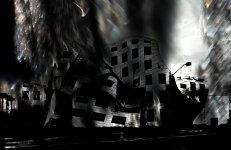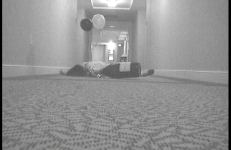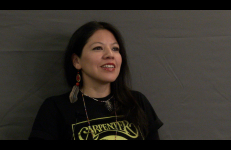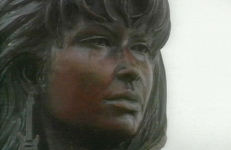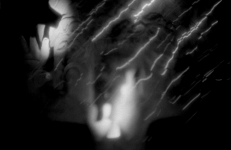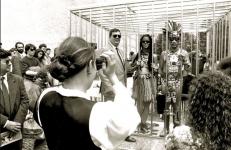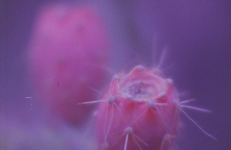This is an audiovisual manifesto in support of people in resistance against a military coup.
Latino/Chicano
"Interested in the hidden corners of exoticism and a reinterpretation of history as an aesthetic challenge, Colombian resident in France, Laura Huertas Millán (Bogotá, 1983), presents in Aequador—in her own words—'a parallel present modified by virtual reality, an oneiric allegory, an uchronic dystopia.' With foundations on science fiction—uchronia as a source for an alternative history can actually be seen as a subgenre—, Aequador establishes parallelisms—in a complex and deliberately fragmented way—between the (virtual) relics and ruins of an ideal 3-D architecture embed
A Kafkian vision of the New World. The arrival of Karl Rossman to the contemporary Babylon under the spell of the paranoid avant-garde. Kinetic coexistence of the archaic forms in dissolution.
A political composition on natural resistance. These images are an expiring breath in danger of extinction. These images become extinguished, consumed: a drop, a pure intensity which only appears when falling. In the presence of the image these audiovisual crowds become an affected body, assaulted by entropy. A face exhausted and reanimated by the continuous sound trance that traverses the battlefield. Faces for an eye that would not need to see.
A significant amount of the hand-drawn animation seen on television today is cartooned in sweatshop-like animation factories in Korea, China, and the Philippines. The writers and animators who form Animaquiladora sharpened their skills in one such factory located in Tijuana, Mexico. After years of animating logos for the American talk show Regis and Kathie Lee, Lalo Lopez and Alex Rivera escaped from the hellish sweatshop of Tijuana to seek better lives in Los Angeles and New York.
This is the common audiovisual system that interconnects the body of the workers and the industrial machinery of the actual system.
Luis Cruz Azaceta (b.1942) creates paintings and mixed media works which use the recurring theme of the displaced individual. Marked by his own exile from Cuba—he emigrated to the U.S. in 1960, in the wake of Castro’s take-over—the artist realized that home is something he carries with him from place to place. Through his piercing expressionism, Azaceta depicts the frailty of human existence in a world full of social anarchy, historically mandated violence, and natural chaos.
Martin Sorrondeguy, former vocalist for Los Crudos, produced this powerful and uplifting documentary about the U.S. Latino punk scene and the DIY movement. The video features live performances by bands, including Huasinpungo, Los Crudos, Subsistencia, Sbitch, and many more.
Sitting at an altar decorated with a kitsch collection of cultural fetish items, and wearing a border patrolman’s jacket decorated with buttons, bananas, beads, and shells, Gómez-Peña delivers a sly and bitter indictment of U.S. colonial attitudes toward Mexican culture and history.
Sitting at an altar decorated with a kitsch collection of cultural fetish items, and wearing a border patrolman’s jacket decorated with buttons, bananas, beads, and shells, Gómez-Peña delivers a sly and bitter indictment of U.S. colonial attitudes toward Mexican culture and history.
This strange, lyrical performance video diary is a millennial reflection on the impossibility to "reveal" one’s self in stormy times such as ours. The piece is also about the intricate connections between performance and everyday life; about language, identity, love, nostalgia and activism amidst the California apocalypse.
In 2002, my troupe, La Pocha Nostra and I were invited to conduct a workshop at Columbia College in Chicago with 15 students and faculty from different departments. At the end of the two-week workshop, we created a large-scale performance-installation with the participants. Canadian video artist Liz Singer was invited to shoot the entire process, from the early workshop exercises, meant to connect students with their bodies and build a sense of community, up to opening night... In this documentary we reveal the working methods and radical pedagogy of La Pocha Nostra.
In 2002, my troupe, La Pocha Nostra and I were invited to conduct a workshop at Columbia College in Chicago with 15 students and faculty from different departments. At the end of the two-week workshop, we created a large-scale performance-installation with the participants. Canadian video artist Liz Singer was invited to shoot the entire process, from the early workshop exercises, meant to connect students with their bodies and build a sense of community, up to opening night... In this documentary we reveal the working methods and radical pedagogy of La Pocha Nostra.
Veronica Majano depicts the character of a street in the Mission District of San Francisco. This street is personified as a fifteen year old Salvadoran/Ohlone girl on a search to understand the changes brought on by colonization, dislocation, and more recently, gentrification. Tracing the history of the Mission from its first residents, the Ohlone Indians, Chula explores the effects of re-colonization on memory and memory loss. For Chula, memory loss is a birthmark that was passed down to her from her ancestors.
A Kafkian vision of the New World. The arrival of Karl Rossman to the contemporary Babylon under the spell of the paranoid avant-garde. Kinetic coexistence of the archaic forms in dissolution.
Spanish painter Chema Cobo discusses his early years of studying and creating art in Southern Spain. His career began in the mid-1970s, exhibiting at the Buades and Vandrés galleries, along with a generation of now-established artists. His work began showing outside of Spain in the ’80s. Cobo also talks about the ways that his Spanish background and identity have informed his work.
A historical interview originally recorded in 1994.
"Emptiness: I just watched your latest video, Colchones Individuales (Single Beds), Volume 1: Desolacion, and I wanted to write you about it. Oddly, Single Beds sums up much of what I have been thinking lately. In these times of speed, where everything is propelled forward at an incredibly spiraling rate, it is only in moments of pause, of inertia, that we examine what is occurring to us. Your piece, Single Beds, performs an arrested time, a succinct suspension of time. (It is in many ways a companion piece to an earlier video of yours Staying Alive).
Colectivo Los Ingrávidos (Tehuacán) is a Mexican film collective founded in 2012 to dismantle the commercial and corporate audiovisual grammar and its embedded ideology. The collective is inspired by the historical avant-gardes, and their commitment to using both form and content against alienating realities. Their methods combine digital and analog mediums, interventions on archival materials, mythology, agitprop, social protests, and documentary poetry.
In this political satire featuring the comedy trio Culture Clash, sharp dialogue, physical comedy, and state of the art video techniques are used to dramatize a mock trial of Columbus in a present-day courtroom. With a “Spanish-by-way-of-Mexico” judge presiding, Columbus on Trial hits on the complexities of Latino identity in America while slicing into the kitschy consumer icons and buzzwords that stand for racial and ethnic identity in contemporary society.
This is the invocation to the gods, the incense to the gods. A kinetic dance to the gods. Behold the hieratic nature of Tonatiuh (The Sun) and the ferocity of Tlaltecuhtli (Goddess of the Earth) raising her agitation from the white smoke of the burned Copalli, Mesoamerican aromatic resin, sacred resin that tears celluloid with smoke, white hair, on the dark background of the world.
In this humorous short, Astrid Hadad, dressed in traditional folkloric costumes and religious garments, sings and performs to a Chilean love ballad before a painterly background of fantastic landscapes. Her hyperbolic posturings enact the song’s tale of a woman’s heartbreak. This satirical presentation of femininity references pathos and the role of the victim. Cuevas’s use of animation and video montage adds a playful tone to the heartfelt melodrama of love songs, familiar touchstones in all cultures.
In a series of 1992 performances, Coco Fusco and performance co-creator Guillermo Gómez-Peña decked themselves out in primitive costumes and appeared before the public as “undiscovered AmerIndians” locked in a golden cage — an exercise in faux anthropology based on racist images of natives. Presented eight times in four different countries, these simple performances evoked various responses, the most startling being the huge numbers of people who didn’t find the idea of “natives” locked in a cage objectionable.
In a series of 1992 performances, Coco Fusco and performance co-creator Guillermo Gómez-Peña decked themselves out in primitive costumes and appeared before the public as “undiscovered AmerIndians” locked in a golden cage — an exercise in faux anthropology based on racist images of natives. Presented eight times in four different countries, these simple performances evoked various responses, the most startling being the huge numbers of people who didn’t find the idea of “natives” locked in a cage objectionable.
Coyolxauhqui recasts the mythical dismemberment of the Aztec Moon goddess Coyolxauhqui by her brother Huitzilopochtli, the deity of war, the Sun and human sacrifice. The film is a poem of perception, one that unveils how contemporary Mexican femicide is linked to a patriarchal history with roots in deeper cultural constructs.




